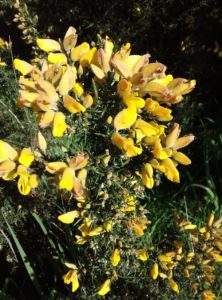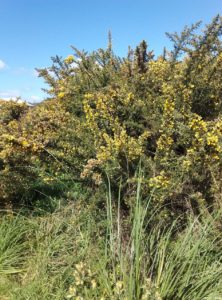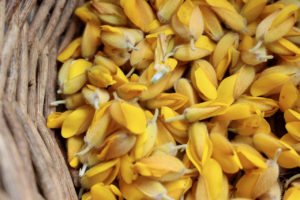Gorse or Furze Ulex europaeus is right now covered in golden-yellow flowers adding colour to our wintery landscape. Not a sight many appreciate due to the bad rap gorse gets as a noxious weed. However, this plant is very important to bees during early spring providing protein rich pollen to grow baby bees (brood) and build the new season’s colony.
Gorse is a very spiny, woody perennial shrub growing up to 2 m or more. After the pea-like flowers black pods appear that split explosively when ripe dispersing the shiny, smooth, round
seeds.
 Gorse in full flower
Gorse in full flower
Gorse has established in New Zealand on thousands of hectares of hill and marginal farming areas. The efforts to spray, disc, slash and burn this plant has not solved the problem. It recovers quickly from burning and heat activates seeds to germinate. The Anglo Saxon word ‘Furze’ or ‘Fyrs’ means ‘a waste’ relating to where it grows or the litter of dead leaves that accumulate under it. The wood is very hard and I’ve seen it used as a flint to start a fire. The ashes of burned gorse are very alkali and were used for washing in place of soap.
Gorse was originally brought to New Zealand for wind breaks and fences, as well as feed for stock. In the UK it was used as fuel for ovens and kilns and fed to cattle and horses after being crushed, ‘gorse and broom (Cytisus scoparius) provide excellent food for horses and sheep and are said to increase the milk yield of cattle’. At one time they were planted as a rotation crop for this purpose. ‘Before the invention of
 Gorse bush - good wind break or hedging
Gorse bush - good wind break or hedging
mechanical crushers … spiny gorse foliage was beaten with wooden mallets or ground down with special stones. In Midlothian in 1795, an acre of gorse could keep six horses for four months, with twenty minutes spent “bruising” the foliage daily.’ It was also given to horses to ‘take the worms out of them’.
Could harvesting gorse for animal feed be a solution to our gorse problem in New Zealand? It grows fast on poor and steep marginal land and it would be a less toxic, perhaps cheaper option where we work with it making the most of its virtues than fighting against it.
Other than animal feed it can be made into pulp and used as paper or bricks.
Being in the Fabaceae or pea family gorse fixes nitrogen from the atmosphere improving the fertility of the soil for native bush seedlings which are protected by the thorny foliage. Once the seedlings outgrow the gorse, the shade gradually kills it. Nesting birds are also protected by the thorns. Gorse is excellent for stabilizing erosion prone land. Use it mulched up around fruit trees or whole branches as protection from rabbits or chickens and over germinating seeds or seedlings to deter mice and birds. In the past gorse and heather were bound together to make besom/witches brooms, which were then tied with the same jute string used for binding straw bales.
 Gorse flowers
Gorse flowers
The flower buds can be pickled, the bark and flowers produce a yellow dye. Gorse flowers have been used to add flavour and colour to beer in Denmark, whiskey in Ireland, and wine and tea in Britain. Gorse flowers are edible and can be added to salads but picking them is a prickly business. The flowers are a Bach flower essence remedy for hopelessness and despair and the soaked gorse seeds have been used as a flea repellent. The sight of the gorse flowers bring me joy. I hope a little more gorse positivity has rubbed off on you too.